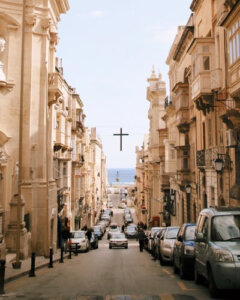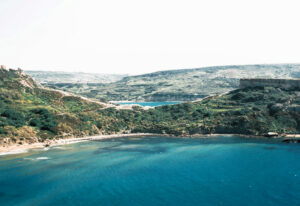Amazing Cart Ruts ⭐ Who build the mysterious tramway in Malta?
In Malta and Gozo, you can find many paired furrows. They were carved into the rock. They are sometimes connected to each other for long distances. Are Malta’s cart ruts the inspiration for London’s Clapham Junction? The track width and depression resemble tramways all over the world.
What are Malta’s Cart Ruts?
Next to their buildings and temples
thousands of years ago, people created a rail-like network in the
network in the rocky surface of Malta. They did not move about at random,
but were sedentary. The Cart Ruts – routes run through valleys,
over passes, to settlements and sometimes disappear into the sea. They
seem to connect places, temples, graves and fields. These ruts
appear like a transport system. The crossings resemble an
old-fashioned railway station of a big city or tracks of modern
marshalling yards. Probably for this reason, the Maltese Cart Ruts were given the nickname
were given the nickname Clapham Junction of the London station.
The Maltese nobleman Gian Frangisk Abela was the first to have the Cart
Ruts explored.
Cart Ruts are an almost unknown attraction in Malta.
Who was Gian Frangisk Abela?
The nobleman Giovanni Francesco Abela (1582-1655) A.G.F. Abele is the author of the book “Description of Malta, island in the Sicilian Sea, with its antiquities, and other information”. In it, he described Malta with its antiquities and other information”. Giovanni Francesco Abela was one of the few Maltese to become a Knight of the Order of Malta.
Born in Valletta, the son of Marco Abela and Benarda Vella is a great-grandson of the Barone di Pietra Lunga, a member of the Spanish royal family. The latter ruled Malta for a time. Giovanni Francesco Abela is considered one of the greatest figures in Maltese history. Abele studied civil and canon law in Bologna. In October 1626, the Order’s Council unanimously appointed him Vice-Chancellor. In 1631, he led the preparations for the convocation of the Order’s General Chapter. A.G.F. Abele was part of the triumvirate for the election of Grand Master Lascaris in 1936. It was under Grand Master Lascaris that the famous defence towers were built in Malta. During his tenure, Abele founded Malta’s first notarial archives.
Noble Giovanni Francesco Abela died on 4 May 1655 and was buried in the Chapel of Our Lady of Philermos (now Chapel of the Blessed Sacrament)) of St John’s Conventual Church. There has been an active Historical Society in his honour since 1950.
What are the dimensions of the Cart Ruts and how deep are they?
The Cart Ruts range from a few centimetres to an astonishing 0.60 metres deep and between 15 and 25 centimetres wide. How do you explain the different depths?
Due to the unevenness, a small depression does not require such a deep track, according to Maltese amateur archaeologist and retired school teacher J. S. Ellul. According to his records from 90 years ago, the builders smoothed out the unevenness in the terrain. The parallel cart tracks are about 120 centimetres apart. In forks and curves, the track is widened to 140 centimetres. A few Cart Ruts found have a length of up to 3 kilometres.
Who was J. S. Ellul?
Born in 1920, Joseph. S. Ellul spent his life studying Malta’s temples, prehistoric monuments and the Cart Ruts. A teacher living in Zurrieq, he was regarded as one of the pre-eminent specialists on Malta’s megalithic sites. Ellul’s family was entrusted with the management of the nearby ruins of Hagar Qim. He shares with many scholars that the collapse of a land bridge between Gibraltar and Morocco created the Mediterranean basin.
How old are the cart ruts in Malta?
There is little evidence for a chronological estimate. Many rational and some less rational theories have been put forward. None has found general acceptance.
- The cart ruts are interrupted by burial shafts. These are attributed to the Punic period of occupation.
- Towards some Neolithic temples, these traces run.
- The Romans built their roads 2000 years ago with a foundation of smaller stones and stone slabs on top.
- Some traces are in the sea. Possibly, 4500 years ago the Mediterranean was less spread.
- They are millions of years old before mankind was wiped out with a tidal wave.
The quote, not all roads lead to Rome, is true for this prehistoric tramway. These cart tracks and cart ruts were most likely created before the Roman period. Many archaeologists estimate the time between 2300 and 1000 BC. During this period, Malta was repopulated. Prehistoric hand tools from the Bronze Age were found in a few places. The material is not found in Malta. Therefore, experts assume that the tool was introduced to Malta at this time.
From this period, wheels were created for the first time in the Mesopotamian city of Uruk. Riddle upon riddle: were wheels invented at the same time worldwide? Or are cart ruts one up to 23 million years old, as the Russian geologist Dr Alexander Koltypin researched? He meant that mankind was wiped out for the first time millions of years ago by a kilometre-high tidal wave. That would explain the cart ruts leading to nowhere. The EU funding program CULTURE 2000 on the cart ruts at universities from Malta, Spain, and Italy did not provide any clarity.
What were the cart ruts used for?
This question remains unanswered to this day. The cart ruts found so far are heavily worn and are said to be unsuitable for in-depth studies. There are conjectures for irrigation or transport. For transportation, two wooden beams or bronze runners and oxen are suspected, so either as pole drags or sledges. Traces in the rock of the hooves of oxen were not discovered until 2022. This is not surprising, because hooves made of horn do not leave traces in the stone. Archaeologists are not sure if there was enough wood on Malta. Other unanswered questions: Can runners be moved in card ruts? Do they get caught? The researcher J. S. Ellul found a lava stone chariot wheel next to the Tarxien temple. He thought 90 years ago that the builders of cart ruts already formed wheels. This is confirmed by the first surviving wheel find.
In which places are card ruts found?
There are more than 30 places where these card ruts exist. Few of them end at sea cliffs. Did Malta have a different footprint at that time? Was Malta directly connected to Europe during its formation? The most famous pairs of tracks can be found in
- Birzebugga
- Borg l-Imramma
- Borġ in-Nadur
- Buskett Gardens
- Dingli Cliffs
- Dwejra Point (früher Azure Window)
- Filfla
- Ghar Hassan, Hal Far
- Ħaġar Qim
- Ix-Xarolla, Zurrieq
- Misraħ Ghonoq
- Mnajdra
- Qala Hill
- Ras il-Pellegrin, Gnejna Bay
- San-Lawrenz
- Skorba
- Ta’-Ċenċ-Plateau
- Ta’ Tingi, Xewkija
- Tal-Baqqari, Zurrieq
- Tal-Qadi
- Tan-Nemes, Qala, Fliegu ta ‘s Gawdex
- Tarxien
- Wardija ta’San Ġorġ
Sources: D. Bradley, J. S. Ellul, Airmalta, M. I. Trinkler, own exploration.
Why are cart ruts found in the ocean?
It cannot be explained rationally. Many questions are unanswered. Maybe cart ruts are much older than the majority of researchers assume. Or is the thesis of Erich von Daniken about the creation by extraterrestrials correct? Did parts of Malta fall into the sea at the cliffs?
For the historian D. Bradley, the cart ruts to the cliffs speak against the construction by the Romans. Because what sense should it have had for the Romans to build roads to 30 meters or 160 meters high cliffs? The book author Josef S. Ellul suspects 90 years ago that the furrows were created even before a Flood. Then you would be several thousand years older. Malta may have been connected to Sicily during its creation. On the other hand, is striking, many cart ruts are found in the south towards Africa and Gibraltar.
Mystery upon mystery. Who will decipher the riddle?
Fancy a puzzle about the Cart Ruts, those mysterious cart tracks?
You have solved the riddle question? Then click on the question, the answer will open.
You can't remember? Maybe you can find the answer in the FAQ.
Which Maltese citizen first researched the mystical Cart Ruts?
The Maltese nobleman Gian Frangisk Abela was the first to research the origin of the Cart Ruts in 1647.
Why are the Maltese cart ruts also called Clapham Junction?
The Cart Ruts in Malta cross each other several times and resemble London's Clapham Junction station. They certainly resemble other stations as well. However, the English occupied Malta for over 150 years. Presumably, the nickname Clapham Junction was established during that time.
What is the assumption behind the different depth grooves of the Cart Ruts?
The Maltese amateur archaeologist Joseph S. Ellul assumed after years of research that this compensated for the unevenness for moving the cart.
We have located a few books and illustrated books about cart ruts in Malta.
- The Maltese Cart-Ruts by Gordon E Western
- Cart-Ruts and their Impact on the Maltese Landscape
- Malta cart ruts – Photo book
- Chariots of the Gods von Erich von Daniken
FAQ – You have questions to cart ruts? We give answers!
Are the cart ruts freely available?
The cart ruts are freely accessible and not marked. Bicyclists have their worries about cart ruts suddenly located on the road.
Are there any records or cave paintings about the cart ruts?
No paintings or written records of cart ruts were found until the 16th century. They were first named in Malta in 1647. The researcher Uwe Topper named the mention of cart ruts in Spanish literature from the year 1794.
Are the card ruts a work of aliens?
This thesis of Erich von Daniken from his book “Chariots of the Gods” is an outsider’s opinion. It has not been confirmed by any archaeologist or researcher.
Are the cart ruts in Malta unique in the world?
No, cart ruts can be found almost everywhere in the world. The cart ruts in Malta are the most famous drag marks. They are considered an archaeological mystery. Other places where cart ruts have been found are Azerbaijan, China, Germany, Japan, Croatia, Libya, Mexico, Portugal, Switzerland, Spain and Mallorca, Austria, Switzerland, Turkey, USA, and some countries of South America. It is not surprising that few means in the creation of cart ruts by extraterrestrials.
Are you missing a question about the mystery? Or do you have something interesting to tell us about cart ruts?
Please contact us. We will be glad to hear from you.





